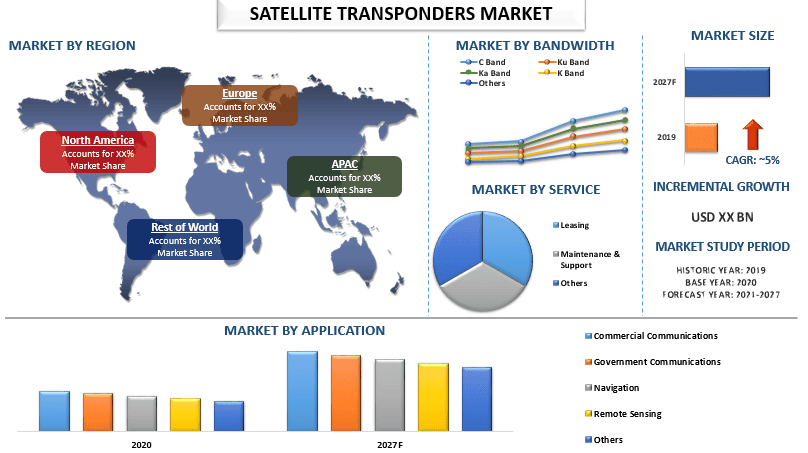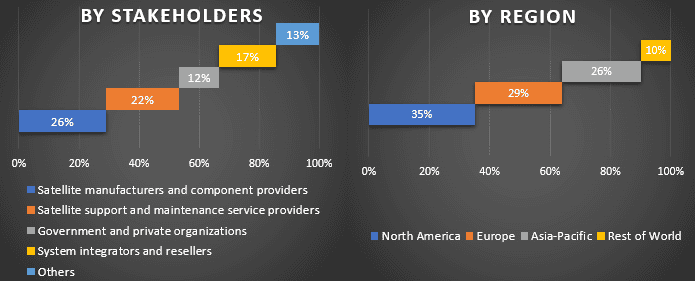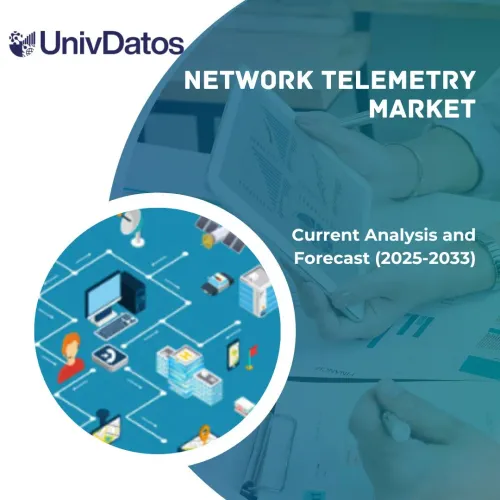- Startseite
- Über uns
- Industrie
- Dienstleistungen
- Lesen
- Kontaktieren Sie uns
Satellitentransponder-Markt: Aktuelle Analyse und Prognose (2021-2027)
Fokus auf Bandbreite (C-Band, Ku-Band, Ka-Band, K-Band und Andere); Service (Leasing, Wartung und Support und Andere); Anwendung (Kommerzielle Kommunikation, Behördenkommunikation, Navigation, Fernerkundung und Andere); sowie Region und Land

Der Markt für Satellitentransponder lag im Jahr 2020 bei rund 19 Milliarden USD und wird im Prognosezeitraum voraussichtlich mit einer CAGR von ~5 % wachsen. Wichtige Faktoren, die das Wachstum des Marktes für Satellitentransponder beeinflussen, sind die steigende Nachfrage nach neuen TV-Plattformen und -Technologien, das Wachstum der Ku-Band- und Ka-Band-Dienste sowie die steigende Nachfrage nach hohen Datenübertragungsraten. Mit der zunehmenden Bildschirmzeit von Fernsehgeräten in den meisten entwickelten und sich entwickelnden Ländern steigt die Nachfrage nach neuen TV-Plattformen und -Technologien. Dies wirkt sich somit auf die Nachfrage nach Satelliten und Transpondern aus. Darüber hinaus wird das Ku-Band im Allgemeinen für Video-, Daten- und Sprachkommunikation verwendet. Auch die zunehmende Akzeptanz der Ka-Band-Frequenz hat für Broadcast- und Kommunikationszwecke mit hoher Bandbreite stark zugenommen. Dies wirkt sich daher positiv auf das Wachstum des Marktes für Satellitentransponder aus.
Im Bericht dargestellte Erkenntnisse
„Unter den Bandbreiten hielt die C-Band-Kategorie im Jahr 2020 einen bedeutenden Marktanteil“
Basierend auf der Bandbreite ist der Markt in C-Band, Ku-Band, Ka-Band, K-Band und andere unterteilt. Im Jahr 2020 machte die C-Band-Bandbreite einen bedeutenden Anteil am globalen Markt für Satellitentransponder aus. Das Umsatzwachstum dieses Segments wird durch die zunehmende Implementierung des C-Bands in Büros und Universitäten angetrieben, da ein umfassender und substanzieller Konnektivitätsbedarf besteht, bei dem die Wahrscheinlichkeit gering ist, dass die Verbindung durch unbeständige Klima- und Umweltbedingungen unterbrochen wird.
„Unter den Dienstleistungen machte die Kategorie Leasing einen wesentlichen Anteil am Markt aus“
Auf der Grundlage von Dienstleistungen wird der Markt in Leasing, Wartung & Support und andere Kategorien unterteilt. Unter diesen hatte Leasing einen bedeutenden Anteil am globalen Markt für Satellitentransponder und wird im Prognosezeitraum voraussichtlich ein starkes Wachstum verzeichnen. Mit dem Aufkommen des Internets auf der ganzen Welt ist Breitband zu einer wichtigen Informationsquelle für jeden Einzelnen auf diesem Planeten geworden. Daher sind die Telekommunikationsunternehmen aktiv auf der Suche nach mehr Transpondern, um Breitbanddienste für die am stärksten abgekoppelten Orte der Welt bereitzustellen. Darüber hinaus treibt die steigende Anzahl von Internetnutzern und Video-Broadcasting-Abonnenten auch den Markt für das Leasing von Satellitentranspondern an. Darüber hinaus haben die meisten privaten und öffentlichen Medienunternehmen die langfristige Vereinbarung zur Verlängerung ihrer Transponder-Leasingzeit aufgrund von Wachstumschancen im Broadcasting-Markt genehmigt.
„APAC wird im Prognosezeitraum voraussichtlich ein deutliches Wachstum zeigen“
Es wird erwartet, dass APAC im Prognosezeitraum eine bedeutende CAGR aufweisen wird. Die steigende Anzahl von Smartphone-Nutzern in der Region aufgrund ihrer Erschwinglichkeit führt zu einer steigenden Nachfrage nach einer besseren Kommunikationskonnektivität. Darüber hinaus aufgrund der steigenden Nachfrage nach DTH-Diensten, High Definition als Ersatz für Standard Definition-Angebote, dem Bedarf an sicherer Kommunikation für Militär und Verteidigung und der großen Rundfunkindustrie in der Region. Dies hat auch Entwicklungsländer wie China und Indien gezwungen, sich auf Satellitentechnologien zu konzentrieren und mehr in den Raumfahrt- und Satellitensektor zu investieren. Darüber hinaus erhöhen mehrere Initiativen der Regierungen verschiedener Länder in der APAC-Region, den Raumfahrtsektor für private Unternehmen zu öffnen, um Satelliten zu entwickeln, um ihnen bei der Expansion ihres Geschäfts zu helfen, die Investitionen deutlich, was voraussichtlich das Wachstum der Markteinnahmen antreiben wird.
Einige der wichtigsten auf dem Markt tätigen Akteure sind SES S.A., The Arab Satellite Communications Organization, Eutelsat Communications S.A., Intelsat S.A., Embratel Star One, Thaicom Public Company Limited, Sky Group Limited, Singapore Telecommunications Limited, Telesat Corporation und Hispasat S.A. unter anderem.
Gründe für den Kauf dieses Berichts:
- Die Studie umfasst Marktgrößen- und Prognoseanalysen, die von authentifizierten wichtigen Branchenexperten validiert wurden
- Der Bericht bietet einen schnellen Überblick über die Gesamtleistung der Branche auf einen Blick
- Der Bericht umfasst eine detaillierte Analyse der wichtigsten Branchenkollegen mit einem primären Fokus auf wichtige Finanzdaten, Produktportfolio, Expansionsstrategien und aktuelle Entwicklungen
- Detaillierte Untersuchung von Treibern, Einschränkungen, wichtigen Trends und Chancen, die in der Branche vorherrschen
- Die Studie deckt den Markt umfassend über verschiedene Segmente hinweg ab
- Tiefgehende Länderanalyse der Branche
Anpassungsoptionen:
Der globale Markt für Satellitentransponder kann je nach Bedarf oder anderem Marktsegment weiter angepasst werden. Darüber hinaus versteht UMI, dass Sie möglicherweise Ihre eigenen geschäftlichen Anforderungen haben. Nehmen Sie daher Kontakt mit uns auf, um einen Bericht zu erhalten, der Ihren Anforderungen vollständig entspricht.
Inhaltsverzeichnis
ForschungsMethodik für die Analyse des globalen Marktes für Satellitentransponder (2019-2027)
Um die Akzeptanz von Satellitentranspondern weltweit zu untersuchen und zu analysieren, werden drei Hauptschritte unternommen: die Analyse des historischen Marktes, die Schätzung des aktuellen Marktes und die Prognose des zukünftigen Marktes. Es wurde eine umfassende Sekundärforschung durchgeführt, um die historischen Marktzahlen zu erfassen und die aktuelle Marktgröße zu schätzen. Zweitens wurden zahlreiche Erkenntnisse und Annahmen berücksichtigt, um diese Einsichten zu validieren. Darüber hinaus wurden umfassende Primärinterviews mit Branchenexperten entlang der Wertschöpfungskette der Satellitentransponderindustrie geführt. Nach der Annahme und Validierung der Marktzahlen durch Primärinterviews haben wir einen Bottom-up-Ansatz verwendet, um die vollständige Marktgröße zu prognostizieren. Danach wurden Methoden zur Aufschlüsselung des Marktes und zur Datentriangulation angewendet, um die Marktgröße von Segmenten und Untersegmenten der betreffenden Branche zu schätzen und zu analysieren. Die detaillierte Methodik wird im Folgenden erläutert:
Analyse der historischen Marktgröße
Schritt 1: Eingehende Untersuchung sekundärer Quellen:
Es wurde eine detaillierte Sekundärstudie durchgeführt, um die historische Marktgröße von Satellitentranspondern aus unternehmensinternen Quellen wie Jahresberichten & Finanzberichten, Performance-Präsentationen, Pressemitteilungen usw. sowie aus externen Quellen wie Zeitschriften, Nachrichten & Artikeln, Regierungsveröffentlichungen, Wettbewerbsveröffentlichungen, Branchenberichten, Datenbanken von Drittanbietern und anderen glaubwürdigen Veröffentlichungen zu erhalten.
Schritt 2: Marktsegmentierung:
Nachdem wir die historische Marktgröße des Satellitentranspondermarktes ermittelt hatten, führten wir eine detaillierte Sekundäranalyse durch, um aktuelle Markteinblicke und Anteile für verschiedene Segmente & Untersegmente für wichtige Regionen zu erhalten. Das Hauptsegment ist nach Bandbreite, Service und Anwendung im Bericht enthalten. Darüber hinaus wurden regionale und länderbezogene Analysen durchgeführt, um die allgemeine Akzeptanz von Satellitentranspondern weltweit zu bewerten.
Schritt 3: Faktorenanalyse:
Nachdem wir die historische Marktgröße verschiedener Segmente und Untersegmente ermittelt hatten, führten wir eine detaillierte Faktorenanalyse durch, um die aktuelle Marktgröße von Satellitentranspondern zu schätzen. Darüber hinaus führten wir eine Faktorenanalyse unter Verwendung abhängiger und unabhängiger Variablen wie die Fähigkeit zur Verarbeitung großer Datenmengen mit Geschwindigkeit und Digitalisierung durch. Es wurde eine gründliche Analyse für Angebots- und Nachfrageszenarien unter Berücksichtigung zunehmender Investitionen, Top-Partnerschaften, Fusionen und Übernahmen, Geschäftsausweitungen und Produkteinführungen in der Satellitentransponderindustrie durchgeführt.
Aktuelle Marktzuschnittsschätzung & Prognose
Aktuelle Marktzuschnitte: Basierend auf umsetzbaren Erkenntnissen aus den oben genannten 3 Schritten ermittelten wir die aktuelle Marktgröße, die wichtigsten Akteure auf dem globalen Satellitentranspondermarkt und die Marktanteile jedes Segments. Alle erforderlichen prozentualen Anteile und Marktaufschlüsselungen wurden unter Verwendung des oben genannten sekundären Ansatzes ermittelt und durch Primärinterviews verifiziert.
Schätzung & Prognose: Für die Marktschätzung und -prognose wurden verschiedenen Faktoren, einschließlich Treibern & Trends, Beschränkungen und Chancen, die den Stakeholdern zur Verfügung stehen, Gewichtungen zugewiesen. Nach der Analyse dieser Faktoren wurden relevante Prognosetechniken, d. h. der Bottom-up-Ansatz, angewendet, um die Marktprognose bis 2027 für verschiedene Segmente und Untersegmente in den wichtigsten Regionen weltweit zu erstellen. Die Forschungsmethodik zur Schätzung der Marktgröße umfasst:
- Die Marktgröße der Branche in Bezug auf Wert (US$) und die Akzeptanzrate von Satellitentranspondern in den wichtigsten Märkten
- Alle prozentualen Anteile, Aufteilungen und Aufschlüsselungen von Marktsegmenten und -untersegmenten
- Schlüsselakteure im Satellitentranspondermarkt. Sowie die von diesen Akteuren angewandten Wachstumsstrategien, um im schnell wachsenden Markt wettbewerbsfähig zu sein.
Validierung von Marktgröße und -anteil
Primärforschung: Es wurden ausführliche Interviews mit den Key Opinion Leaders (KOLs) geführt, darunter Führungskräfte der obersten Ebene (CXO/VPs, Vertriebsleiter, Marketingleiter, Betriebsleiter, Regionalleiter, Länderleiter usw.) in den wichtigsten Regionen. Die Ergebnisse der Primärforschung wurden dann zusammengefasst, und es wurde eine statistische Analyse durchgeführt, um die aufgestellte Hypothese zu beweisen. Die Ergebnisse der Primärforschung wurden mit den sekundären Erkenntnissen zusammengeführt, wodurch Informationen in umsetzbare Erkenntnisse umgewandelt wurden.
Aufteilung der primären Teilnehmer nach Stakeholdern und Regionen

Market Engineering
Die Datentriangulationstechnik wurde verwendet, um die gesamte Marktschätzung abzuschließen und präzise statistische Zahlen für jedes Segment und Untersegment des globalen Satellitentranspondermarktes zu erhalten. Die Daten wurden nach Untersuchung verschiedener Parameter und Trends im Bereich Bandbreite, Service und Anwendung in mehrere Segmente & Untersegmente unterteilt.
Das Hauptziel der Satellitentransponder Marktstudie
Die aktuellen & zukünftigen Markttrends globaler Satellitentransponder wurden in der Studie genau bestimmt. Investoren können strategische Einblicke gewinnen, um ihre Entscheidung für Investitionen auf der Grundlage der in der Studie durchgeführten qualitativen und quantitativen Analyse zu treffen. Aktuelle und zukünftige Markttrends würden die Gesamtattraktivität des Marktes auf Länderebene bestimmen und eine Plattform für den Industrieteilnehmer bieten, den unerschlossenen Markt zu nutzen, um als First-Mover-Vorteil zu profitieren. Weitere quantitative Ziele der Studien sind:
- Analyse der aktuellen und prognostizierten Marktgröße von Satellitentranspondern in Bezug auf den Wert (US$). Analysieren Sie auch die aktuelle und prognostizierte Marktgröße verschiedener Segmente und Untersegmente
- Das Segment in der Studie umfasst den Bereich Bandbreite, Service und Anwendung
- Definierte Analyse des regulatorischen Rahmens für die Satellitentransponderindustrie
- Analyse der Wertschöpfungskette mit der Anwesenheit verschiedener Vermittler sowie Analyse des Kunden- und Wettbewerberverhaltens der Branche
- Analyse der aktuellen und prognostizierten Marktgröße von Satellitentranspondern für die wichtigsten Länder
- Wichtige Regionen/Länder, die im Bericht analysiert werden, sind Nordamerika (USA, Kanada, Rest von Nordamerika), Europa (Deutschland, Großbritannien, Frankreich, Italien, Spanien, Rest von Europa), Asien-Pazifik (China, Japan, Indien, Australien, Rest von Asien-Pazifik) und Rest der Welt
- Unternehmensprofile der Akteure auf dem Satellitentranspondermarkt und die von ihnen angewandten Wachstumsstrategien, um sich im wachsenden Markt zu behaupten
- Detaillierte Länderanalyse der Branche
Verwandt Berichte
Kunden, die diesen Artikel gekauft haben, kauften auch










